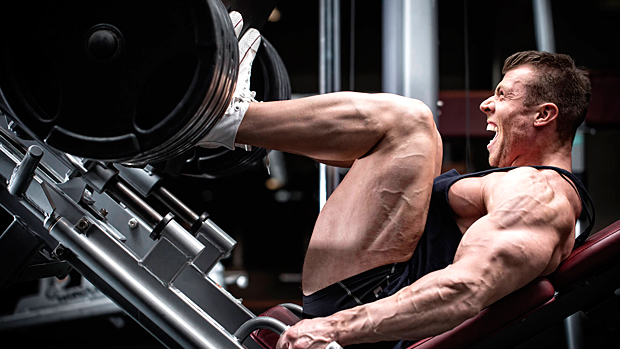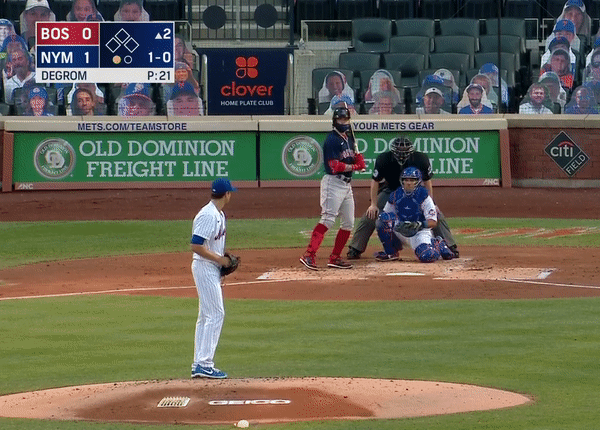
Let’s create a scenario.
You’ve just finished up your last practice for the fall and you’re building out offseason plans for your pitching staff this winter. Out of all of your players, there’s one in particular that really makes you excited. As a freshman, this kid has a chance to be a really special player. He’s long and lanky at 6’4 and weighs just 160 pounds, but don’t let the scale fool you. This kid can throw. Despite having twigs for arms and legs, this kid can already run it up to 84-87. Just imagine what his velo would look like if he got a steady dose of deadlifts and protein shakes this offseason. You decide to give him a goal: If he shows up at 175 next spring, he’ll touch 90.
When he showed up next spring at 180 lbs., you couldn’t have been happier. His skinny arms and twig legs were now chiseled with muscle thanks to an aggressive bodybuilding-style workout program. All of his compound lifts had doubled, his physicality was night and day, and he was looking exactly how you hoped when you envisioned his 90 mph body. He wasn’t going to be sitting 84-87 anymore when he started throwing off a mound again. He was going to be touching 91-92 with ease.
That’s where it gets interesting.
In his first bullpen of the year, his fastball didn’t even touch 83. Figuring he’s just shaking off some rust, you don’t get worried and decide to see how things play out. This changes when he’s one month into practices, his fastball hasn’t touched 84, and his elbow throbs every time he picks up a ball. You can’t figure it out. This kid did everything you asked him, crushed the weight room, added 20 lbs., and now his velo has fallen off a cliff. You don’t just feel bad. You feel like someone has repeatedly punched you in the gut until you can’t breathe anymore. The guy who was supposed to be one of your top three arms might not be able to throw any meaningful innings at all this year. The best part?
You only have yourself to blame.
Remember when you thought he wasn’t big or strong enough at the end of the fall? Turns out, that young man was actually pretty strong in the first place. He just didn’t fit the mold of what most of us tend to think of as strong. The situation from above wasn’t made up. In fact, it happens a lot more than you would think. Young, eager athletes looking for more velocity often try to find solutions in the weight room and at the dinner table. This is because we currently have a catchy phrase going around in baseball: Mass = Gas. The translation is pretty simple. Players who weigh more are able to throw the ball harder.
The application, however, is not so simple.
Mass equals gas might sound catchy to say, but it’s not totally accurate. The young man from above – along with the many others who have made his same mistake – are great reminders that adding mass can hurt performance as much as it can help it. This article is going to attempt to explain why.
Where did Mass = Gas come from?
Before we get into the pitfalls of adding mass, let’s start with where the idea of mass = gas comes from. We don’t have to go any further than Isaac Newton’s second law of motion: Force equals mass times acceleration (F=M*A).
According to Newton’s findings, the amount of potential force a system can produce is dependent on its mass and how quickly it’s able to overcome inertia. This is pretty straight forward. If it’s heavier and it gets up to speed faster, it’s probably going to do a lot more damage. From a training perspective, this seems to transfer well. Justin Verlander, Madison Bumgarner, and Noah Syndergaard aren’t small dudes. They’re physical specimens with a big motor and a quick trigger.
The average weight for an MLB player has steadily increased over the last several decades. In 1970, the average big leaguer weighed about 184 pounds. Today, that number is north of 200 lbs. As of 2017, the average MLB pitcher weighed in at about 215 pounds – a 25-pound increase from 1970. This past season, the average weight of starting pitchers with the top 10 hardest fastballs was 210.8 lbs. This list included:
- Luis Castillo (97.4 mph, 200 lbs.)
- Dinelson Lamet (97.0 mph, 228 lbs.)
- Gerrit Cole (96.7 mph, 225 lbs.)
- Brandon Woodruff (96.6 mph, 215 lbs.)
- German Marquez (95.9 mph, 225 lbs.)
- Yu Darvish (95.8 mph, 225 lbs.)

As you can see, the majority of the arms on this list exceed 200 lbs. This itself isn’t a bad thing. Additional mass can absolutely have a positive influence on performance. However, it’s not because F=M*A. Newton’s laws give us information about force production in linear systems. They fall short when applied to rotational systems. This is a problem if we’re trying to gauge force output in rotational athletes.
If we want to explain why mass can positively influence pitching velocity, we have to think using a slightly different lens. This is where torque comes into play.
I was fortunate to talk about this topic with Jimmy Buffi – current CEO of Reboot Motion and former analyst with the Los Angeles Dodgers. Torque is something Buffi brought up because it gives Newton’s laws more depth when it comes to force production in rotary athletes. By definition, torque measures the forces that cause an object to rotate about its axis. This is really important for baseball players. Force is plane specific. If we want to gauge how much force a pitcher is able to produce, we need to look at the planes of motion in which that force is being produced. Torque helps us do just that.
Below is the equation for torque:
- Torque = Inertia*Angular Acceleration
I know it seems a little complicated at first glance, but it doesn’t have to be. The first part of the equation – inertia – can be calculated as follows:
- Inertia = Mass*(Radius^2)
- This is the most simplified equation for Inertia. Feel free to read more about this here.
This is pretty straight forward. Inertia simply looks at how heavy something is and how far the mass is being applied in relationship to the center axis of rotation (radius). We’ll dive into this one in just a second. First, let’s break down the second part of the equation: Angular Acceleration.
- Angular Acceleration = Angular Velocity/Time
Don’t get too lost in physics on this one. Angular vector quantities simply give us information about how something is moving in a circular motion (i.e. rotation). Velocity over an elapsed period of time gives us information on acceleration. As a result, angular acceleration is going to give us information about how something is accelerating during a rotational movement.
So why the hell is any of this important when it comes to mass = gas?
Let’s go back to inertia. If you’re in the mass = gas crowd, you should pay close attention to this part. According to inertia, an increase in mass or an increase in the distance from the axis of rotation is going to result in greater torque. The more torque you can create, the more velocity you can produce. This is important. If the mass you’re adding helps you produce more torque, you’re going to be able to throw the ball harder. Newton’s laws kind of alluded to this, but using torque helps us clarify it. If we’re dealing with rotary athletes, we have to measure how force is being produced rotationally. Linear equations don’t cut it.
Alright, easy enough. Baseball players with more mass should produce more force based on what we know about torque. Therefore, adding more mass should help you throw harder.
Come on, you didn’t think it was going to be that simple. Did you?
Why are some players able to throw gas without mass?
Nathan Garza is the Director of Strength and Conditioning for the Oral Roberts University baseball team. When I asked him about his thoughts on the topic of mass = gas, he brought up a specific athlete he works with on the baseball team. At 130 lbs., this kid doesn’t really catch your eye at first glance. What makes him stick out is what he does on the field. Despite weighing nearly less than 100 lbs. under the MLB average for a pitcher, this kid has a fastball that touches 91 miles per hour.
If that isn’t enough, Garza tested this kid in a non-countermove vertical jump where he took the stretch shortening cycle away from him. He jumped 39 inches. To give you some perspective on this, Seattle wide receiver DK Metcalf – arguably the most physical athlete in the entire draft – jumped 40 inches with a countermove at the 2019 NFL Combine. Garza’s kid might be skinny, but you can’t convince him he isn’t strong. He just isn’t strong in the way we typically think of strength. We’ll get into this more in a few.
At TCU, Dechant has two specific pitchers who are able to run it up to 95 and 96, respectively. One weighs in at 165 pounds. The other weighs 177 pounds. These kinds of players might seem like outliers, but they’re actually more common than you think. Below is a list of elite MLB pitchers who sit well below 215 lbs:
- Josh Hader (95.3 mph, 185 lbs.)
- Walker Buehler (96.8 mph, 185 lbs.)
- Dustin May (97.7 mph, 180 lbs.)
- Chris Sale (94.6 mph, 180 lbs.)
- Zack Wheeler (97.0 mph, 195 lbs.)
- Marcus Stroman (94.1 mph, 180 lbs.)
- Pedro Martinez (95-98 mph, playing weight – 170 lbs.)
Out of the five hardest average fastballs in 2020, two were owned by players who weighed 195 lbs. or less. One of them was Wheeler. The other was this guy:
- Jacob deGrom (98.6 mph, 180 lbs.)

In 2020, deGrom’s heater was a full 1.2 mph harder than any other qualifying starter. Thirty-three of his pitches were thrown 100 mph or harder. He weighs less than all but two of Dechant’s baseball players at TCU. If we look beyond the scale, we realize this is no coincidence. There are some things that deGrom does exceptionally well that allow him to throw gas with much less mass.
To Dechant, two things stand out:
- Exceptional Movement Quality & Sequencing
If we were to sum up guys like Stroman, deGrom, and Pedro using a single word, one stands out: Efficient. They have an elite movement signature which allows them to produce more force per pound than anyone else in the world. There’s no wasted movement or unnecessary tension. They move to and through strong positions and sync up their body beautifully – in Dechant’s words – so the right segments are speeding up and slowing down at the right times. If they only have 175 pounds to work with, they’re getting all 175 transmitted into the ball at release.
Having mass and leveraging mass to create velocity are not the same thing. Just because you have it doesn’t mean you’re using it well.
- Arm Unwinds Beautifully
The best arms in the world might throw from different slots, angles, and postures, but they all share a key characteristic: The arm takes a specific path around the torso where the humerus, forearm, wrist, and hand all work in the same plane around the spine. This is called arm efficiency – and the best all have it.



Mass might play a role in creating velocity, but pitchers like deGrom, Pedro, and May are physical proof it’s only one thing. You don’t have to weigh 200 lbs. to throw a baseball 95 mph, but you do have to move really well. If the mass you put on doesn’t help you do this, we get situations like the one we started with.
This is where putting our faith into mass = gas becomes a big problem.
Why can adding mass hurt performance?
Let’s go back to Garza’s athlete from above. If that young man at 130 lbs. were to walk into most strength rooms across the country, you’d likely get an overwhelming consensus he needs to get stronger and put on some pounds. This might sound great in theory, but there can be some significant consequences to this approach without context. These start with the system controlling motor function: The Central Nervous System (CNS).
Building out a quality training program requires you prepare that athlete holistically for competition. This preparation involves the CNS as much as it does the muscles. If you’re not stimulating the CNS in ways that mirror the demands of throwing a baseball 95 mph, you’re not properly preparing that athlete. Exercises like bilateral squats and and deadlifts might help your legs get stronger, but they don’t even come close to reciprocating the CNS demands of pitching a baseball. If we spend the majority of our time training our CNS to move maximal loads at submaximal speed, our CNS is going to adapt accordingly. Garza said it best: “You’re pulling their CNS in two different directions.”
If we spend the majority of our time training our CNS to move maximal loads at submaximal speed, our CNS is going to adapt accordingly. (Nathan) Garza said it best: “You’re pulling their CNS in two different directions.”
Garza’s athlete from above doesn’t throw 91 because he can deadlift a house. He throws 91 because he has an incredibly efficient CNS. If you don’t train these things, they don’t just hang around. You lose them. This is part of the reason why the young man from above had a sharp decline in performance. Training the CNS to move heavy stuff slow does not teach it how to move light stuff fast. When the training demands don’t match the demands of competition, performance suffers.
If we go to the connective tissue level, additional mass can negatively impact the amount of force you’re able to produce. This is something Buffi talked about: Not all added mass is created equal. Lean muscle mass can generate force and torque. Fat mass cannot. While adding muscle mass can help, Buffi noted it can also have an adverse impact on the ranges of motion used to throw a ball 95 mph. This, in his experience, can become a problem.
“Sometimes, when players add a lot of muscle mass, they actually reduce range of motion because the muscles are bigger and take up more space,” said Buffi. “Adding more muscle might increase the ability to create force and acceleration… but it might reduce the distance and time over which you can apply that force. So, there could be a trade off here between the magnitude of force production and the amount of time over which you can apply that force.”
This can also have a subsequent impact on movement quality. If the mass you’re putting on doesn’t help you move to and through good positions, you’ve just created a barrier to performance. This barrier becomes tough to break – especially if you try to attack it using the same movement signature. There’s a really good chance our kid from the beginning ran into this problem. The positions and ranges of motion he was once able to access were no longer at his disposal. He thought he was doing a good thing by adding muscle mass, but what he put on ended up getting in his way. If the body changes and the movement solutions don’t, something is going to break until they do. In this case, it was his elbow.
Alright, so let’s recap.
We know where mass equals gas comes from and the pitfalls of looking at linear equations when it comes to rotational athletes. We have a pretty good idea why adding mass can help or hurt a player’s performance. We also know about some things that make athletes with less mass able to throw gas. However, we still have a poor kid with a barking elbow and in need of some help. Where exactly do we go from here?
Well, it depends – but there is one thing we do not want to do.
Designing the Program
There are several different things Dechant focuses on with his athletes at TCU. Chasing mass is not one of them. He uses the scale as feedback and has ranges he likes his players to fall under, but he never makes adding mass an objective. For him, any kind of mass his players need should be the byproduct of a plan that addresses:
- Consistent and quality training habits
- Nutrition
- Hydration
- Sleep
If his players can take care of these things, the numbers on the scale should take care of themselves.
As for the training itself, we need to first be able to assess and categorize the players in front of us so we can make good training decisions. For the sake of this article, we’re going to break down two different populations of athletes that fall on opposite ends of the spectrum: “Muscle bound” players and “string beans.”
When it comes to muscle bound guys, there are a few common themes that tend to stick out:
- Very strong under a barbell, lots of concentric power
- Limited Rate of Force Development (RFD), tough time overcoming inertia
- Aches, pains, chronic ailments
- Movement inefficiencies created through compensatory patterns
- Huge engines, bad brakes
If we were plot these guys on the force velocity curve, they would be all the way to the left. They can produce a ton of force but can’t express it very quickly. This is a problem when it comes to baseball. Our ability to produce elite velocity does not come down to our ability to deadlift or squat a certain amount of weight. The baseball weighs just five ounces. Increasing the amount of potential force we can produce does not mean it’s all getting into the baseball.
For Garza, the easiest way to connect with muscle bound athletes is to start with where they’re hurting. In his experience, nearly all of these athletes have some sort of aches, pains, or chronic discomfort. This typically happens because at some point in time moving more weight became more important than moving well. This is exactly why Dechant titled his book Movement over Maxes. If you sacrifice how you move for how much you max, you’re throwing the whole purpose of the weight room out the window.
In order to get to the bottom of these inefficiencies, Garza assesses how the move on the mound and in the weight room. He looks for compensations and gets to the root of what is causing them. Improving he pattern will improve the pain they’re experiencing. When they can start to build some better solutions, Garza wants to teach these guys how to move stuff fast. These guys don’t need to add another 15 pounds to their front squat max. They need to learn how to express the force they already have. This starts with improving their rate of force development (RFD).
Some exercises to improve this include:
- Sprinting
- Ballistic Rotation
- Jumping & Landing
- Change of Direction work
Garza also modifies compound lifts where the objective is to move lighter loads at faster speeds. This might not create the same level of satisfaction as a set of heavy deadlifts, but it’s a lot closer to something they actually need. Remember: The baseball only weighs five ounces. Training to move heavy stuff slow does not help you move light stuff fast.
Now let’s go to the other side of the spectrum.
In order to determine the lowest hanging fruit for “string beans,” Garza explained how he utilizes his four Key Performance Indicators (KPIs) for the weight room:
- Bilateral compound lift
Garza doesn’t have specific metrics athletes need to hit for bilateral compound lifts (very individualized), but he does like to shift the focus away from them when athletes can get into the 2X BW range for deadlift and 1.75X for a front squat pattern.
- Single leg lunge variation
Single leg variations (e.g. barbell reverse lunge) give Garza a lot of information on how well an athlete is able to stabilize their spine, produce, and accept force on one leg. As a general rule of thumb, he likes to see his guys be able to lunge their bodyweight for six to 10 quality reps.
- Vertical Jump
Garza will test all of his athletes to see what their vertical jump looks like with and without a countermove. This gives him information on how well – or not so well – the athlete is able to leverage the stretch shortening cycle to produce force. Garza likes to see about a 10% difference between the two, but he’ll often see greater than 10% with his elastic driven athletes and less with his muscle driven athletes. The “twitchier” you are, the more skilled you are at using the SSC to overcome inertia. Muscle driven athletes tend to struggle with this.
- 30 yard sprint with 10 yard split
Using the 30 yard sprint with 10 yard splits gives Garza a lot of information on how well athletes can accelerate and get up to top speed. Muscle driven athletes tend to win in the first 10 as acceleration largely depends on strength and technique. Elastic athletes tend to win in the last 20 as they are much better at creating stiffness throughout the system and rapidly contracting/relaxing. Muscle driven athletes might know how to turn things on, but they’re not so great at knowing when to turn them off. Comparing the 30 yard time and the 10 yard split gives Garza a pretty good picture for where they fit on that spectrum.
Garza will collect information from the KPIs, do a thorough assessment of the skill, and prioritize his findings to determine where he’ll start his training interventions. For the sake of simplicity, let’s look at two different examples and how each requires a slightly different approach:
Athlete A: Performs well on field, not in weight room
This kind of athlete can be challenging from the perspective of a strength coach because they might have zero interest in strength training at all. If they can throw significantly harder than the rest of their teammates who lift significantly more, why should they care about getting “stronger?” If the weight room was really that important, shouldn’t the kids who lift more be able to throw harder?
In this kind of a situation, Garza tries to relate the weight room to the field as much as possible. He’ll start his sessions with specific exercises that target movement movement qualities all baseball players need. Of these include pelvic stability, rotation, and motor control. When teaching these movements, he’ll use language and analogies that relate it back to their swing or delivery. This helps build buy in. Instead of just force-feeding bilateral lifts down their throats, Garza starts with the thing that’s most important, invites engagement, and back chains from here.
By taking something that’s unfamiliar and teaching it in a way that is familiar, you increase the chances they’ll learn and retain it.
When it comes to the less specific work, Garza doesn’t look at it as just lifting weights. He views it as a big skill acquisition process. Patterning a good front squat is just like patterning out an efficient delivery: You’re teaching a skill. It’s going to go through a phase where it stinks (unconscious/conscious incompetence), it’s going to require deliberate work and practice to improve (conscious competence), and the goal is to get it to a point where it can be executed without conscious thought (unconscious competence). By taking something that’s unfamiliar and teaching it in a way that is familiar, you increase the chances they’ll learn and retain it.
When it comes to the KPI’s, Garza doesn’t lose sleep if they aren’t deadlifting twice their bodyweight in two months. The KPI’s are information – not predictors of performance. Throwing 90 mph is a lot more than how much you can squat, lunge, or how fast you can run. The objective is to build quality training habits that positively influence performance. Whatever they add to the bar should be a byproduct of this – not the other way around.
Athlete B: Doesn’t perform well on field or in weight room
This athlete isn’t as delicate of a project. Their lowest hanging fruit is often going to be a combination of strength and increased movement efficiency. Improving general strength will get you a pretty good return on your investment because these guys need some sort of foundation to produce force from. However, this doesn’t mean you just start lifting like a bodybuilder and crushing bilateral lifts four times per week. There needs to be an on ramping process where athletes master the patterns prior to loading them. Dechant describes this process as “slow-cooking” the athlete. Skipping to level 10 right out of the gate might sound exciting, but it’s a great way to expose your athletes to demands they aren’t prepared for. Play the long game. Strength added to dysfunction only magnifies dysfunction.
Something to also be cognizant of with this type of population is how their body changes. Putting detrained athletes on a good program will have an impact on body composition, lean muscle mass, and joint range of motion. These changes, as mentioned above, will have a subsequent impact on their delivery. Don’t get caught trying to fit a square peg into a round role. Use your knowledge of the skill and their new body to reposition them into positions of best leverage. It’s often bad news if one thing changes and the other doesn’t…
The weight room can be a huge asset to the detrained and unskilled population of athletes. Just keep the main objective in mind when you go about it…
Doing this the right way
Let’s finally go back to the situation we started with.
This athlete falls under the first type of athlete we broke down – Athlete A who excels on the field but struggles with the weights. If we were to redo his training program, we need to get some background:
- Assess the delivery
- What are the things he does well?
- What kind of inefficiencies does he present with?
- What are his greatest opportunities for improvement?
- Define his training age
- What is his experience in the weight room?
- Can he execute movements under the bar with proficiency?
- Where does he potentially compensate?
- Determine when he needs to be game ready
- Work backwards from game one.
- How much undivided time do you have with him in the weight room prior to the start of practices?
- When does the focus need to shift to more skill specific activities?
From here, we can start to build out the basics. The backbone of his training will address his targeted movement inefficiencies. Correcting them will involve time deliberately crafting fundamental movement patterns (e.g. hinge, push, lunge) and eventually synchronizing more dynamic movements (e.g. sprinting, landing, throwing). The progression to build these patterns will mirror the skill acquisition process: Build the pattern, challenge it to progress it, and regress it when it’s not proficient.
It might not be as fun to “slow cook” your athlete, but it’s going to keep them on the field in the long run. Performance and health need to be the priority. Chasing numbers right out of the gate jeopardizes both.
You might feel the urge to start loading the patterns right away when you start to see some improvements. Here’s my advice: Don’t. Be patient with this process early on. It might not be as fun to “slow cook” your athlete, but it’s going to keep them on the field in the long run. Performance and health need to be the priority. Chasing numbers right out of the gate jeopardizes both.
The more dynamic the movement, the more taxing it’s going to be on the CNS. As a result, activities like throwing and sprinting should be done at the beginning of sessions when the athlete is most fresh. Throwing is most important. Whatever is done in the weight room should supplement the throwing. After all, we remember what happened when lifting became more important than throwing…
Intensity, frequency, and duration of sessions should be balanced based on the demands of throwing and lifting. Each athlete only has so much training economy they can exert throughout the course of the day. If the throwing is more intense, the lifting has to be less intense to prevent overtraining. A great way to monitor this is to use a RPE (rare of perceived exertion) scale. Ask the athlete after each session how difficult it was on a scale of 1-10. This will help you understand what they can handle, what they’re struggling with, and how much you need to program so you can get the desired training effect. Your assumptions don’t often match up to what they’re actually experiencing. Don’t assume – just ask.
If the training is executed consistently and correctly, the athlete should start to progressively see improvements in pain, movement efficiency, and performance. If they’re not, the program needs to be re-evaluated. While some things may see tremendous improvement early on (e.g. general strength), other things might take more time (e.g. pitching velocity). This is where the role of a coach comes into play. If your program is creating positive movement adaptations that are creating transfer, don’t abandon ship when you don’t see instant velo jumps. If you take care of the big rocks the details will fall into place. That is, if you focus on the right things in the first place…
If these things are done consistently and effectively, this athlete very well has a chance to show up next spring up 2-3 mph. He might even put on a couple pounds, but it’s not because he tried to. It’s because he focused on the things that allowed him to.
If Mass doesn’t equal Gas, what does?
I don’t think it’s fair to put together an equation for creating velocity. There are too many different variables that influence whether someone is able to throw 95 mph. However, there is one thing I’m pretty sure of: Mass does not equal gas. Mass plays a role in throwing gas, but it’s only one thing. Let’s keep it that way.
To conclude, I think we should make a slight revision to mass = gas. I got this one from Lantz Wheeler:
- Mass + Improved Movement Efficiency = Gas
I think that’s a little better, for now.
